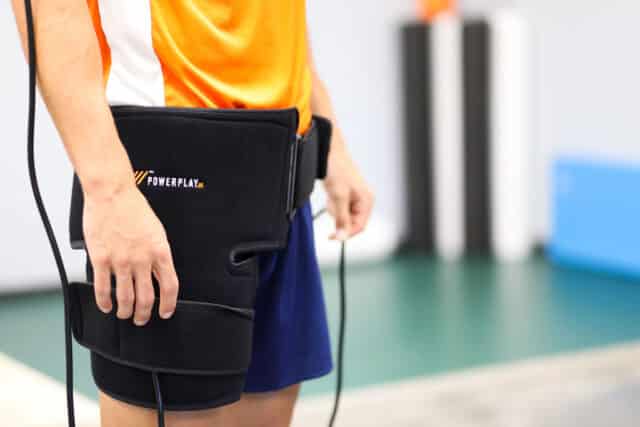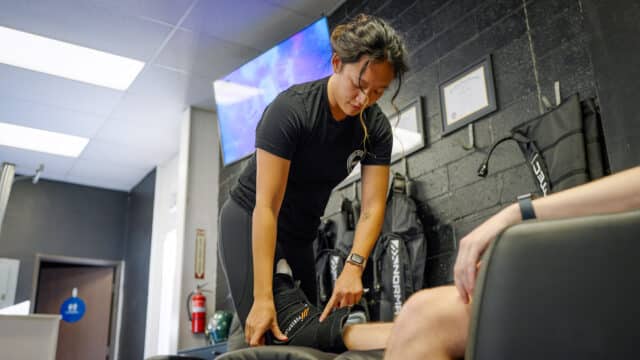Cold therapy has become a go-to for athletes at all levels. Whether you’re training for your first 5K or competing professionally, understanding how to effectively “chill out” can make a real difference.
This guide walks you through various methods, or modalities, of cold therapy for athletes, ranging from simple ice packs to ice baths and advanced cold compression systems.
Understanding Cold Therapy Basics
Cold therapy, also known as cryotherapy, has been a staple in training routines for decades. It’s all about harnessing the body’s natural physiological responses to cold temperatures.
Cold causes vasoconstriction in tissues, narrowing blood vessels and reducing blood flow to the area. This process can help limit swelling and provide a temporary numbing effect on nerve endings.
Athletes at various levels incorporate cold therapy into their routines in two primary ways:
- Post-exercise recovery: Cold therapy is commonly used after intense training sessions or competitions to manage exercise-related discomfort and prepare for the next round.
- Post-injury recovery: Trainers and physical therapists often prescribe ice packs or other forms of cold therapy following an acute injury or surgery.
Common Cold Therapy Modalities
Ice Packs
Ice packs are the most accessible and widely used type of cold therapy for athletes. These portable cooling agents come in various forms, including:
- Homemade ice bags (ice cubes in a plastic bag wrapped in a towel)
- Commercial gel packs that can be stored in a freezer
- Chemical cold packs that activate when crushed or bent
- Clay-based cold packs for longer-lasting cooling
Ice packs are typically applied to specific areas for localized treatment and can be wrapped around joints or placed on sore muscles to provide relief.
Ice Baths and Cold Immersion
Whole body cryotherapy (WBC) involves submerging the body in cold water, often with added ice to maintain lower temperatures. This method offers a more comprehensive cold exposure compared to localized treatments, like ice packs.
Because full-body immersion cools more intensely than localized methods, ice bath sessions are typically shorter in duration. Water temperatures range from approximately 10°C to 15°C (50°F to 59°F).
Many professional sports teams have dedicated ice bath facilities, while home users might use a bathtub or specially designed cold plunge tubs. The full-body exposure makes this method less suitable for injuries or localized pain, and more ideal for generalized recovery after intense competition or heavy training sessions.
Cold Compression Devices
Cold compression therapy combines the benefits of cold with those of compression. These systems typically consist of a wrap or sleeve that contains cooling elements and provides controllable compression.
The dual-action approach targets two aspects of recovery simultaneously:
- The cold component helps manage discomfort
- The compression element assists with fluid movement and provides supportive pressure
These systems vary in complexity, ranging from simple sleeves with ice inserts and Velcro straps to advanced electronic units with precise temperature and pressure controls.
Additional Cold Therapy Methods
Cold therapy is a broad term, and simple approaches to cold therapy may be more accessible than you think!
- Cold showers: Cold showers provide a convenient (and less intense) alternative to ice baths.
- Ice massage: Involves rubbing ice directly on a specific area, often using a frozen water cup with one end exposed. Ice massage can provide very targeted cooling with the added benefit of massage pressure.
- Contrast therapy: Alternating between hot and cold treatments, such as moving between a hot tub and cold plunge or applying alternating hot and cold compresses.
Comparing Cold Therapy Options
Various cold therapy modalities allow individuals, trainers, and healthcare providers to adjust the variables for different applications.
Temperature Control and Intensity
- Ice baths provide significant cooling with moderate temperature control (you can adjust by adding more ice or water), making them one of the more intense options for whole-body application.
- Ice packs deliver moderate cooling with limited temperature control once applied, though different types of packs cool at different rates.
- Iceless gels can provide a more moderate and sustained cooling effect.
Coverage Area and Targeting
- Localized treatments (ice packs, cold compression wraps) target specific muscles, joints, or small body regions, allowing for precise application to areas of concern.
- Full-body methods (ice baths, cold plunges) affect multiple body systems simultaneously and are often chosen for general recovery rather than addressing specific areas.
Convenience and Accessibility
- Portability: Ice packs and certain compression devices can be transported and used almost anywhere.
- Setup requirements: Ice baths and some compression devices require significant preparation (filling a tub, adding ice, monitoring temperature) compared to simply applying an ice pack or using a pre-filled compression wrap.
- Cost considerations: Options range from very affordable (homemade ice packs) to significant investments in specialized cold compression systems or dedicated cold plunge tubs.
PowerPlay Cold Compression Systems
PowerPlay offers a modern approach to cold therapy, combining the benefits of cooling with active compression in a portable, user-friendly system. You’ll find PowerPlay systems in:
- Athletic training rooms: Where multiple athletes may need treatment simultaneously
- Physical therapy settings: For supervised therapy protocols
- Home use: For consistent access to cold compression therapy
- Travel packs for teams: Providing therapy options during away competitions
How PowerPlay Works
The PowerPlay system centers around a portable compression pump that delivers pressure through a flexible hose connected to joint-specific wraps. With five adjustable pressure settings (30 mmHg to 70 mmHg), the pump creates intermittent, sequential compression that simulates the kneading and stroking of tissue with the hands, helping to improve circulation in the treated area.
PowerPlay’s specialized wraps are designed for different body parts with adjustable straps for a comfortable fit.
Re-freezable iceless gels fit into each wrap, adding an optional element of cold therapy that closely conforms to the joint. Requiring just one hour in the freezer before use, gel packs eliminate the need for messy ice and heavy equipment—great for both clinical and home use.
Distinctive Features and Benefits
PowerPlay offers several advantages compared to other cold therapy options:
- Multi-user capability: The system features three ports for compression therapy, allowing for the simultaneous treatment of up to three individuals (wraps are single patient use) or the application of up to three joint wraps on a single user.
- Portability: Weighing around one pound, the control unit is highly portable and offers 4-8 hours of continuous battery use, perfect for travel and on-the-go recovery.
- User-friendly design: The system operates with simple one-touch technology, automatically starting a timed therapy session.
- Price point: PowerPlay is priced below many competitive cold compression machines, allowing users to purchase multiple wraps at the price of one competing product.*
*PowerPlay Single Pack ($499-$549) compared to Hyperice Normatec 3 ($799) or a Game Ready Cold and Compression Machine at ($3,037) as of April, 2025.
Up Your Cold Therapy Game!
Cold therapy offers a versatile toolkit for enhancing your training routine and managing muscular discomfort. From basic ice packs to advanced systems like PowerPlay, you’ve got options to personalize your approach based on your specific needs and training situation.
Consult with your trainer or doctor to determine which cold therapy methods are best suited for you. Be sure to explore the full range of PowerPlay wraps and packs available in our store!





